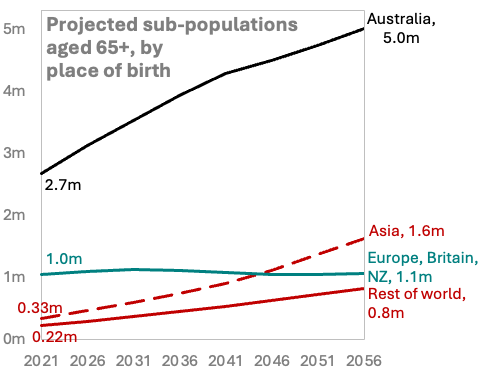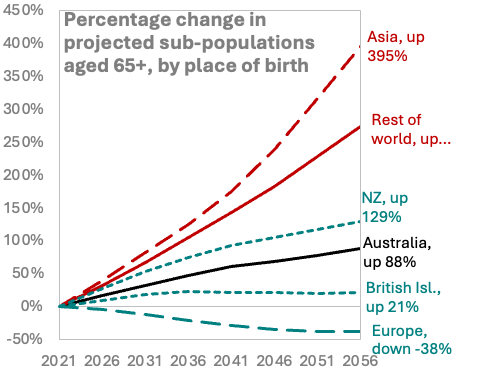New projections show how migrant backgrounds and cultural and linguistic diversity are set to boom among older Australians, according to a new research brief on migration and ageing, published by the ARC Centre of Excellence in Population Ageing Research (CEPAR).
New projections
Over the last decade, the average Australian has become one year older and three percentage points more likely to have been born overseas.
This trend is feeding into the older population in Australia, according to the report: By 2056, there will be about five times as many older Australians from Asia as there were in 2021, and they will make up a fifth of the older population aged 65+.
By then, a third of the older population is expected to be from non-English-speaking countries. Numbers of older Australians from South Asia will grow the fastest.
How migration offsets ageing
The report shows both how migration affects the cultural makeup of the older population and how it offsets the rate of population ageing.
“Pre-pandemic migration levels, alongside further increases in mature age labour force participation, would be enough to stabilise some of the economic impacts of population ageing,” says Peter McDonald, CEPAR Chief Investigator and Honorary Professor of Demography at the University of Melbourne.

Projected populations aged 65+ by place of birth. Credit: Chomik, R., Khan, F.J., and Temple, J. (2024), CEPAR.
Potential vulnerabilities
“Australia is better than most countries in integrating migrant communities,” he says.
“Much of that is because of our skilled migration program. But the report shows that some migrants find the labour market challenging.”
Challenges in working age can translate to risks in retirement. For example, culturally and linguistically diverse migrants tend to have fewer superannuation savings, a lower likelihood of owning a home, and lower financial literacy, according to the report.
“While migrants typically arrive with better health than the Australian born population average, this health advantage tends to dissipate over time and their probability of disability in old age increases faster than for people born in Australia,” says Rafal Chomik.
“This has implications for the aged care system, especially, as we also found, because culturally and linguistically diverse communities have a strong preference for home care over residential care. With a boom in diversity of Australia’s older population the shift to more home-based care services will need to be faster than otherwise expected,” he says.
Diversity is not a minority issue
The report shows Australia is already very diverse.
About a half of Australian adults were born overseas or had parents born overseas, over a third were migrants, and a quarter were born in a non-English speaking country.
“There are also major differences by age. For example, by ancestry: While the majority of Boomers are Anglo-Celtic, Millennials are probably the least European and first minority Anglo-Celtic generation since colonisation,” says Rafal Chomik.
Read the research brief here.
– ENDS –
About us:
About CEPAR
The Australian Research Council (ARC) Centre of Excellence in Population Ageing Research (CEPAR) is a unique collaboration between academia, government and industry, committed to delivering solutions to one of the major economic and social challenges of the 21st century. The research centre is based at the University of New South Wales, with nodes at the Australian National University, Curtin University, The University of Melbourne and The University of Sydney.
Contact details:
Available for interviews:
· Rafal Chomik, CEPAR Senior Research Fellow, UNSW Business School
· Peter McDonald, CEPAR Chief Investigator, University of Melbourne
Media contact
Silke Weiss, CEPAR, [email protected]
The research brief is available online to download for free at cepar.edu.au/sites/default/files/2024-CEPAR-Research-Brief-Migration-Ageing.pdf


